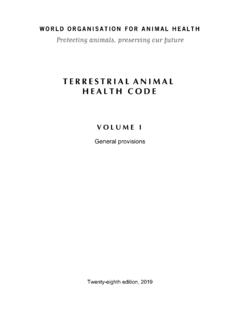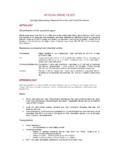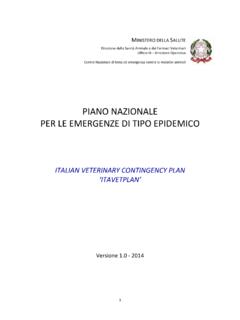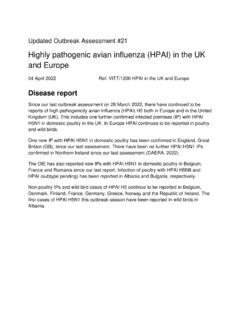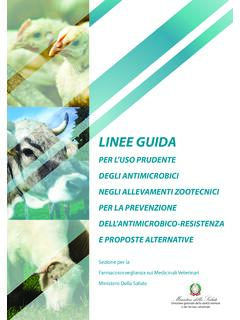Transcription of The FAO Action Plan on Antimicrobial Resistance 2021 2025
1 THE FAO Action PLAN ON Antimicrobial RESISTANCE2021 2025 Supporting innovation and resilience in food and agriculture sectors and Follow us on social media and join the conversation using these hashtags: #AMR #StopSuperbugs #OneWorldOneHealth #ZeroHungerTwitter: @FAO and @FAOL ivestockFacebook: UNFAOI nstagram: FAOYouTube: FAOoftheUN Food and Agriculture Organization of the United NationsRome, ItalyCB5545EN/1 978-92-5-134673-09789251346730 The FAO Action Plan on Antimicrobial Resistance2021 2025 Food and Agriculture Organization of the United NationsRome, 2021 Supporting innovation and resiliencein food and agriculture sectorsThe designations employed and the presentation of material in this information product do not imply the expression of any opinion whatsoever on the part of the Food and Agriculture Organization of the United Nations (FAO) concerning the legal or development status of any country, territory, city or area or of its authorities, or concerning the delimitation of its frontiers or boundaries.
2 Dashed lines on maps represent approximate border lines for which there may not yet be full agreement. The mention of specific companies or products of manufacturers, whether or not these have been patented, does not imply that these have been endorsed or recommended by FAO in preference to others of a similar nature that are not views expressed in this information product are those of the author(s) and do not necessarily reflect the views or policies of FAO. ISBN 978-92-5-134673-0 FAO, 2021 Some rights reserved. This work is made available under the Creative Commons Attribution-NonCommercial-ShareAlike IGO licence (CC BY-NC-SA IGO; ). Under the terms of this licence, this work may be copied, redistributed and adapted for non-commercial purposes, provided that the work is appropriately cited. In any use of this work, there should be no suggestion that FAO endorses any specific organization, products or services.
3 The use of the FAO logo is not permitted. If the work is adapted, then it must be licensed under the same or equivalent Creative Commons licence. If a translation of this work is created, it must include the following disclaimer along with the required citation: This translation was not created by the Food and Agriculture Organization of the United Nations (FAO). FAO is not responsible for the content or accuracy of this translation. The original English edition shall be the authoritative edition. Disputes arising under the licence that cannot be settled amicably will be resolved by mediation and arbitration as described in Article 8 of the licence except as otherwise provided herein. The applicable mediation rules will be the mediation rules of the World Intellectual Property Organization and any arbitration will be conducted in accordance with the Arbitration Rules of the United Nations Commission on International Trade Law (UNCITRAL).
4 Third-party materials. Users wishing to reuse material from this work that is attributed to a third party, such as tables, figures or images, are responsible for determining whether permission is needed for that reuse and for obtaining permission from the copyright holder. The risk of claims resulting from infringement of any third-party-owned component in the work rests solely with the , rights and licensing. FAO information products are available on the FAO website ( ) and can be purchased through Requests for commercial use should be submitted via: Queries regarding rights and licensing should be submitted to: citation:FAO. 2021. The FAO Action Plan on Antimicrobial Resistance 2021 2025. Rome. of this document .. summary ..viiBackground ..1 FAO s vision ..7 FAO s goals on AMR ..9 Objectives ..11 Objective 1: Increasing stakeholder awareness and engagement ..13 Objective 2: Strengthening surveillance and research.
5 14 Objective 3: Enabling good practices ..15 Objective 4: Promoting responsible use of antimicrobials ..16 Objective 5: Strengthening governance and allocating resources sustainably ..17 Key Activities for 2021 2025 ..19 Monitoring Framework of the FAO Action Plan on Antimicrobial Resistance 2021 2025 ..27 References ..31 Contacts ..35 FAO/Marco LongarivPreparation of this documentThis FAO Action Plan on Antimicrobial Resistance 2021-2025 is the continuation of the first FAO Action Plan, which covered the period 2016-2020. The document was developed through the coordination of Keith Sumption and Junxia Song (Joint Centre for Zoonotic Diseases and AMR) and the multidisciplinary effort from all the decentralized offices and divisions forming part the FAO AMR Inter-Departmental Working Group that covers the wide range of thematic areas across food and agriculture sectors (food safety, Codex Alimentarius, animal health and production, plant production and protection, fisheries and aquaculture, water and environment, surveillance and epidemiology, legislation, information and communication).
6 Part of the consultative process was the internal review of the initial draft with inputs and advice from FAO AMR Working Group colleagues in headquarters and decentralized offices: Gu Baogen, Daniela Battaglia, Daniel Beltran-Alcrudo, Sarah Cahill, Marisa Caipo, Domingo Caro III, Frederic Castell, Mark A. Caudell, Myoengsin Choi, Katinka de Balogh, Marlos de Souza, Beed Fenton, Mary Joy Gordoncillo, Nicolas Keck, Jieun Kim, Tabitha Kimani, Eva Kohlschmid, Sasha Koo-Oshima, Jeffrey LeJeune, Yingjing Li, Markus Lipp, Friederike Mayen, Ki Jung Min, Koen Mintiens, Beatrice Mouille, Scott Newman, Mark Obonyo, Henk Jan Ormel, Irene Ouoba, Julio Pinto, Eran Raizman, Melba Reantaso, Artur Shamilov, Beate Scherf, Tenaw Andualem Tadege, Berhe Tekola, Kim-Anh Tempelman, Jiani Tian, Michael Treilles, Carlos Vaquero and Jing Xu. Several rounds of consultations with Members followed with the presentation of the document to the 27th Session of the Committee on Agriculture, the 34th Session of the Committee on Fisheries and the 130th Session of the Programme Committee, until the final version was approved during the 166th Session of the FAO Council in April lead authors developing original contents and refining the document through consultations were Alejandro Dorado-Garcia, Francesca Latronico, Lina Yu, Antonio Valcarce, Irina Curca, Cortney Price, Emmanuel Kabali, Carmen Bullon, Alice Green and Armando E.
7 Hoet. Christine Czerniak and Brett Shapiro provided editing and proofreading services, and Claudia Ciarlantini and Giada Semeraro supported the design and publication Antimicrobial resistanceAMU Antimicrobial useCAC Codex Alimentarius Commission FAO Food and Agriculture Organization of the United NationsFAO-ATLASS FAO Assessment Tool for Laboratories and AMR Surveillance SystemsFAO-PMP-AMR FAO Progressive Management Pathway for AMRGAP Global Action Plan on AMR GDP Gross domestic productIACG UN ad hoc Inter-agency Coordination Group on AMRICCPM International Code of Conduct on Pesticide ManagementIPPC International Plant Protection Convention LMIC Low- and middle-income country MPTF Multi-Partner Trust FundNAP National Action Plan on AMROIE World Organisation for animal HealthSDG Sustainable Development Goal TISSA Tripartite Integrated System for Surveillance on on AMR/AMUUN United NationsUNEP United Nations Environment
8 ProgrammeWAAW World Antimicrobial Awareness WeekWHO World health OrganizationviiExecutive summaryFAO Conferences in 2015 and 2019 underscored the importance and urgency of addressing the growing global threat of Antimicrobial Resistance (AMR) in all countries through a coordinated, multisectoral, One health ap-proach in the context of the 2030 Agenda for Sustainable Development. They highlighted that access to effective antimicrobials and their appropriate and prudent use has a role in productive and sustainable agriculture and aqua-culture and that their misuse contributes to the rising rates of AMR which negatively impacts the advances made in medicine, public health , veterinary care, food and agriculture production systems, and food safety. The confer-ences highlighted also that access to effective Antimicrobial agents consti-tutes a prerequisite for productive and sustainable agriculture, particularly animal husbandry and aquaculture and safe food, on which countless liveli-hoods depend throughout the world, but that hard-won gains in animal and human health and development are at risk due to increasing Resistance to antimicrobials.
9 Contributing towards the goal of building resilience in the food and agriculture sectors by limiting the emergence and spread of AMR de-pends on controlling AMR effectively as a shared responsibility among farm-ers, herders, growers, fishers, prescribers and policy-makers in food and agri-culture as well as other sectors. Preventive Action will provide an economic benefit, especially when compared to the considerable percent of GDP ex-pected to be lost if AMR is permitted to develop into a global emergency through the widespread failure of availability and use of effective antimicrobials is essential for the health and welfare of terrestrial and aquatic animals, and in crop produc-tion. The overuse and misuse of antimicrobials in animal and plant production is influenced by an interplay of factors. These serve as targets for Action to address challenges ranging from: i) treatment failures driving production losses and food insecurity; to ii) the impacts on human individuals become carriers of Antimicrobial -resistant microorgan-isms, they can easily spread AMR among communities and across borders.
10 AMR can also reach the general population by spilling over into agriculture products and the environment, contaminating waterways, wild-life and soil. Given the global interconnected web of transmission, a multi-sectoral and multidisciplinary approach is critical to the success of National Action Plans (NAPs) for delivering on the Global Action Plan on AMR (GAP; WHO, 2015). This FAO Action Plan on AMR 2021 2025 sets out the five objectives that guide the programming of FAO activities. The latter will be amend-ed as needed to reflect progress, new challenges, and available resources. The Action plan principally is intended to help guide FAO s support to its Members to build capacities, and is not a policy document. The Action Plan provides for flexibility to respond to Members requests and participation of Members in activities indicated is voluntary. The activities and support provided under the Action Plan will be guided by the latest develop-ments in science, international guidance and standards.










